RBSE Class 12 Biology Important Questions Chapter 6 Molecular Basis of Inheritance
Rajasthan Board RBSE Class 12 Biology Important Questions Chapter 6 Molecular Basis of Inheritance Important Questions and Answers.
RBSE Class 12 Biology Chapter 6 Important Question Molecular Basis of Inheritance
Multiple Choice Questions
Question 1.
In a DNA strand the nucleotide are linked together by:
(a) glycosidic bonds
(b) phosphodiester bonds
(c) peptide bonds
(d) hydrogen bonds
Answer:
(b) phosphodiester bonds

Question 2.
A nucleoside differs from a nucleotide. It lacks the:
(a) base
(b) sugar
(c) phosphate group
(d) polysaccharides
Answer:
(c) phosphate group
Question 3.
Both deoxyribose and ribose belongs to a class of sugars called:
(a) trioses
(b) tetroses
(c) pentoses
(d) hexoses
Answer:
(c) pentoses
Question 4.
DNA length per turn of helix is:
(a) 3.8Å
(b) 3.4Å
(c) 6.8Å
(d) 34Å
Answer:
(d) 34Å
Question 5.
DNA multiplication is called:
(a) transiation
(b) replication
(c) transduction
(d) transcription
Answer:
(a) transiation
Question 6.
The intiation codon in eukaryotes is:
(a) AUG
(b) UGA
(c) UAG
(d) UAA
Answer:
(a) AUG
Question 7.
Scientists who proved that DNA is a genetic material are:
(a) Hershey and Chase
(b) Watson and Crick
(e) Sutton and Boyen
(d) Griffith and Mccarty
Answer:
(a) Hershey and Chase
Question 8.
Who proposed widely accepted double helical model of DNA?
(a) Watson and Crick
(b) Sutton and Boyen
(c) Erwin Chargaff
(d) Griffith
Answer:
(a) Watson and Crick
Question 9.
Which one is not found in DNA?
(a) Adenine
(b) Cytosine
(c) Thymine
(d) Uracil
Answer:
(d) Uracil
Question 10.
How many base pairs are present in a nucleosome?
(a) 1oo pb
(b) 200 pb
(c) 300 pb
(d) 400 pb
Answer:
(b) 200 pb
Question 11.
Name the genetic material in TMV:
(a) Protein
(b) DNA
(c) RNA
(d) None of these
Answer:
(c) RNA
Question 12.
Who proposed operon concept?
(a) Jacob and Monod
(b) Watson and Crick
(c) Alec Jaffreys
(d) Har Govind Khorana
Answer:
(a) Jacob and Monod

Question 13.
Who developed chemical method for synthesising RNA molecule with defined base combinations to develop the genetic code?
(a) Marshall Nirenberg
(b) Hargovind Khorana
(c) Severo Ochava
(d) Francis Crick
Answer:
(b) Hargovind Khorana
Question 14.
Who proposed central dogma of molecular biology?
(a) Francis Crick
(b) Watson
(c) Kornberg
(d) McLeod
Answer:
(a) Francis Crick
Very Short Answer Type Questions
Question 1.
What are the two types of nucleic acids present in living system?
Answer:
Two types of nucleic acids present in living system are: DNA and RNA.
Question 2.
Who was the first to identify DNA and what was the name given to it by him?
Answer:
DNA was first isolated by Friedrich Meischer in 1869, who named it as nuclein.
Question 3.
Who proposed the famous double stranded helical structure of DNA?
Answer:
James Watson and Francis Crick in 1953.
Question 4.
What do you mean by nucleoid?
Answer:
In prokaryatos, the DNA is organised in large loops held by positively charged proteins in a region called nucleoid.
Question 5.
What is the function of histone in DNA packging?
Answer:
Histones are basic proteins. The side chains of their basic amino acids carry positive charge and stabilises negatively charge DNA into nucleoprotein fibre.
Question 6.
What are retroviruses?
Answer:
Group of viruses containing RNA as hereditary material.
Question 7.
What is genetic code?
Answer:
It is the sequence of base triplet in a DNA molecule which determines the sequence of amino acids in a polypeptide.
Question 8.
Define codon.
Answer:
The triplet bases on mRNA that codes for a particular amino acid is called codon.
Question 9.
Define translation.
Answer:
The polymerisation of amino acids to form polypeptide with the help of mRNA, ribosome and tRNA is called translation.

Question 10.
What do you understand by transformation?
Answer:
It is a biological phenomenon by which the DNA from one type of cell when introduced into another type, is able to bestow some of the properties of the former to the letter.
Question 11.
What is cistron?
Answer:
The segment of DNA coding for polypeptide is known as cistron.
Question 12.
Name the positively charged protein around which the negatively charged DNA wrapped.
Or
Name the negatively charged and positively charged components of a nucleosome.
Answer:
Histone proteins forming an octamer is the positively charged component and the DNA helix is the negatively changed component of nucleosome.
Question 13.
Name the transcriptionally active region of chromatin in a nucleus.
Answer:
Euchromatin (lightly stained) is the transcriptionally active region of chromatin in a nucleus.
Question 14.
Name the enzyme that transcribe /mRNA in eukaryotes.
Or
Write the function of RNA polymerase - II.
Answer:
The RNA polymerase-II transcribes the precursor of mRNA, i. e., the heterogenous nucleuar RNA (hnRNA).
Question 15.
Why does hnRNA undergo splicing? Where does splicing occur in the cell?
Answer:
hnRNA undergoes splicing to remove non-coding sequence, i. e., introns and joins exons. Splicing occurs in the nucleus of the cell.
Question 16.
How does a degenerate code differe from an unambiguous one?
Answer:
When some amino acids are coded by more than one codon, the code is said to be degenerate.
Question 17.
Write the two specific codons that a translational unit of mRNA is flanked by one on either sides.
Answer:
Two specific codons that are flanked on either sides of mRNA in a translational unit are:
- Initiation codon (AUG).
- Termination Codon (UAG or UAA or UGA).
Question 18.
Give one example of a codon having dual function.
Answer:
AUG is a codon with dual functions. It codes for the amino acid metheonine (met) and also acts as an initiator codon of polypeptide synthesis during protein synthesis.
Question 19.
“Genetic code is unambiguous and specific”. Explain.
Answer:
One codon codes for only one amino acid, hence genetic code is called unambiguous and specific.
Question 20.
Name one amino acid, which is coded by only one codon.
Answer:
Methionine.
Question 21.
Write the dual purpose served by deoxyribo - nucleoside triphosphate in polymerisation.
Answer:
Deoxyribose triphosphate (dNTps) serve the dual purpose of:
- acting as a substrate.
- providing energy (from two terminal phosphates).
Question 22.
Name the two basic amino acids that provide positive charges to histone proteins.
Answer:
Lysine and arginine.
Question 23.
Name the enzyme that joins the small fragment of DNA of a lagging strand during DNA replication.
Answer:
DNA ligase.
Question 24.
Which one of the two subunits of ribosome oncovnters an mRNA?
Answer:
Smaller subunit.
Question 25.
Mention any two ways in which Single Nucleotide Polymorphisms (SNPs) identified in human genome, can bring out revolutionary changes in biological and medical science.
Answer:
- By tracing human history.
- By finding chromosomal locations. For disease associated sequences.
Short Answer Type Questions-I
Question 1.
State any two structural differences and one functional difference between DNA and RNA.
Answer:
|
DNA |
RNA |
|
1. It is a double stranded structure. |
1. It is a single stranded structure. |
|
2. It contains nitrogen bases: adenine, guanine, cytosine and thymine. |
2. It contains nitrogen bases: adenine, guanine, cytosine and uracil. |
|
3. It has deoxyribose sugar. |
3. It has ribose sugar. |
Functional Difference:
|
It determines sequence of amino acids in a polypeptide by transcription and passes information from one generation to next. |
It is the site of translation. |
Question 2.
What do you understand by Nucleoside and nucleotide?
Answer:
Nucleoside: A nitrogenous base is attached to the pentose sugar by an N - glycosidic linkage to form a nucleoside.
Nucleotide: When a phosphate group is attached to -OH of 5’C ot ntrcleoside through phosphodiester linkage, a nucleotide is formed.

Question 3.
What do you understand by central dogma?
Answer:
Francis Crick proposed the central dogma of molectilar biology. Which states that genetic information flows from DNA to mRNA (transcription)
and then from mRNA to protein (translation) always unidirectionally (excepts bîdirectionally in some viruses and the process is called reverse transcription).

Question 4.
Briefly explain the contribution of the following:
(a) Friedrich Miescher
(b) Levene
(c) Chargaff
(d) Watson and Crick.
Answer:
(a) Friedrich Miescher (1869) first identified DNA as an acidic substance and named it nuclein.
(b) Leven (1910) found that DNA contains phosphoric acid as well as deoxyribose sugar. He also found that four types of nucleotides are present in DNA.
(c) Erwin Chargaff proposed that for a double stranded DNA, the ratio between purines (adenine + guanine) and pyrimidines (thymine + cytosine) are constant and equals to one,
\(\frac{A+G}{T+C}=1\)
(d) Watson and Crick (1953) proposed double helix model of DNA base on X - ray diffraction data proposed by Wilkins, and Franklin.
Question 5.
What is genetic code? What is its importance?
Answer:
Genetic code is a sequence of three nucleotides present on mRNA, which codes for a specific amino acid during translation. It is the relationship between the sequence of nucleotides on mRNA and the sequences of amino acids in the polypeptide chain.
Question 6.
Differentiate between a cistron and an exon.
Answer:
Differences between a cistron and an exon.
|
Cistron |
Exon |
|
1. Cistron is segments of DNA that posses both exon and intron. |
1. Exons are coding regions of a gene that code for different proteins. |
|
2. It refers to the whole gene. |
2. It refers to a part of gene. |
Question 7.
Differentiate between exons and introns.
Answer:
Differences between exons and introns.
|
Exons |
Introns |
|
1. Regions of a gene which become part of mRNA. |
1. Regions of a gene which do not form part of mRNA. |
|
2. Code for the different proteins and hence called coding sequence. |
2. Removed during the processing of mRNA because they are non - coding sequences. |
Question 8.
Discuss the role enzyme DNA ligase plays during DNA replication.
Answer:
DNA ligase facilitates the joining of Okazaki fragments in lagging DNA strands together by catalysing the formation of phosphodiester bond. It also plays a role in, repairing single - strand breaks in duplex DNA.
Question 9.
In a typical nucleus, some regions of chromatin are stained light and others dark. Explain why is it so and what is its significance?
Answer:
In a typical nucleus, some regions of chromatin are strained light because of loose packing of chromatin and some regions of chromatin are stained dark because, chromatin is densely packed. Euchromatin is transcriptionally active chromatin (lightly stained) while heterochromatin (darkly stained) is transcriptionally inactive.
Question 10.
Following are the features of genetic codes. What does each one indicate?
Stop codon, Unambiguous codon, Degenerate codon, Universal codon.
Answer:
- Stop Codon does not code for any amino acids, e.g.,UGA.
- Unambiguous Codon codes for only one amino acid, e.g., CCG codes for proline.
- Degenerate Codon, genetic code is to described as degenerate when a single amino acid is coded by more than one codon, e.g., serine is coded by 6 codons.
- Universal Codons codes for the same amino acid in all organisms (except in mitochondria and few protozoans).
Question 11.
What is aminoacylation? State its significance.
Or
Explain aminoacylation of tRNA.
Answer:
Aminoacylation of charging of tRNA is a process in which amino acids get activated in the presence of ATP and get linked to their congate tRNA.
Significance of Aminoacylation: The charged tRNA carries amino acids to the site of protein synthesis. If two charged tRNAs are brought close to each other, the formation of peptide bond is favoured energetically.
Question 12.
Describe the structure of a nucleosome.
Or
Draw a labelled diagram of a nucleosome. Where is it found in a cell?
Or
How do histone acquire positive charge?
Answer:
A nucleosome is a basic unit of DNA packaging in the nucleus of a eukaryote cell, which consisting of a segment of DNA wound in sequence around histone protein cores. The nucleosome is the fundamental subunit of chromatin. Each nucleosome is composed of a little less than two turns of DNA wrapped around a set of eight proteins called histones, which are known as a histone octamer. Each histone octamer is composed of two copies each of the histone proteins H2A, H2B, H3, and H4.
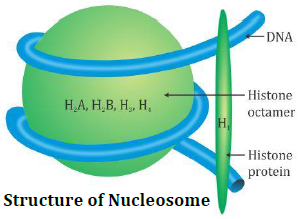
Question 13.
Differentiate between the genetic codes given below:
(i) Unambiguous and Universal.
(ii) Degenerate and Initiator.
Answer:
(i)
|
Unambiguous Codon |
Universal Codon |
|
1. In genetic code, one codon codes for only one amino acid, hence |
1. The genetic code is universal i.e., each codon codes for same amines acid in all organisms. |
(ii)
|
Degenerate Codon |
Initiator Codon |
|
1. Some amino acids are coded by more than one codon, hence the code is degenerate, e.g., serine, leucine, arginine are encoded by 6 codons. |
1. These codons acts as start signal for translation, e.g., AUG acts as intiator codon and |
Question 14.
State the function of ribozyme and release factor in protein synthesis, respectively.
Answer:
In bacteria ribozyme is 23S rRNA, that acts as an enzyme for the formation of a peptide bond between two amino acids. Release factor binds to the codon (UAA) to terminate translation and release the complete polypeptide.
Question 15.
Although a prokaryotic cell has no defined nucleus, yet DNA is not scattered throughout the cells explain.
Answer:
Prokaryotic cells do not have defined nucleus. However, the DNA is not scattered throughout the cell. This is due to the fact that the negatively charged DNA is held with some positively charged protein in nucleoid or the middle region. In this region, the DNA is organised in large loops held by proteins.
Question 16.
What is an origin of replication in a chromosome? State its function.
Answer:
Replication does not initiate randomly at any place in DNA (chromosome). So, there is a particular region in DNA known as origin of replication. It is the site from where DNA replication originates. It helps in propagation of a piece oif DNA, during recombinant DNA procedure.
Question 17.
What is termination codon? What is its critical role?
Answer:
Termination codon is one of three triplet sequences UAG (amber), UAA (ochre) or UGA (opal). The terminator codon stops the ribosome from reading the massage further and leads to the release of the polypeptide chain formed on the rbiosomes.
Question 18.
What is transcription? Explain.
Answer:
Formation of RNA over DNA template is called transcription. Both the strands of DNA do not transcribe RNA, but only one of them does it. Transcription requires enzyme RNA polymerase. All the three species of RNA are produced through transcription.
Question 19.
Name the components of ribo nucleotide and deoxyribonucleotide.
Answer:
Ribonucleotide: Ribose sugar, a base (except thymine) and phosphoric acid.
Deoxyribonucleotide: Deoxyribose sugar, a base (except uracil) and phosphoric acid.
Question 20.
Write four goals of human genome project.
Answer:
Goals of human genome project:
- Optimization of the data analysis.
- Sequencing the entire genome.
- Identification of the complete human genome.
- Creating genome sequence databses to stare the data.
Question 21.
What is transcription? What are the different parts of a DNA transcription unit? What is their role in the process of transcription?
Answer:
Transcription: Formation of RNA over DNA template is called transcription. Both the strands of DNA do not transcribe RNA, but only one of them does it. Transcription requires enzyme RNA polymerase. All the three species of RNA are produced through transcription.
The segment of DNA that takes part in transcription is called transcription unit. It has three components, (i) a promotor, (ii) the structural gene and (iii) a terminator. Promotor starts the transcription, structural gene code for the synthesis of specific polypeptides and terminator stops the transcription.

Question 22.
Write down the four salient feature of genetic code.
Answer:
The perticularity of each cell, individual lies in uniqueness of its proteins. The cells are capable of synthesising - specific proteins by the information flowing from DNA. This information exists as the particular sequences of nitrogeneous bases in the DNA stands and forms the basis of genetic code. It moves to the protein manufacturing machinery (in cytoplasm) in the form of mRNA synthesised on DNA template. The sequence of amino acids in the polypeptide (which is to be synthesised) is determined by the sequence of bases in the mRNA.
It means the precise sequence of only four nitrogenous bases on the DNA strand directs the proper amino acids to their proper places in a polypeptide chain through the intervention of four nitrogenous bases of RNA, i. e., A, G, C and U. Nature of Genetic Code : There are 20 types of amino acids formed in cytoplasm and only four types of nucleotides are present in DNA. Apparently one - to - one correlation between nucleotides and amino acids is not possible. If one base codes for one amino acids, only four amino acid could be specified, i.e., the protein could contain only four amino acids. If a sequence of two bases codes for one amino acid, the four bases could spacify 1 - 6 (4 x 4) amino acids.
It does not fulfil the requirement of an appropriate genetic code. George Gamow, a physicist in 1954 argued that since there are only four nitrogenous bases but they have to code for 20 amino acids, each codon should have a combination of three nitrogenous bases, i.e., a combination of three bases would generate 64 codons (43 = 4 x 4 x 4 = 64 codons). Hence, a sequence of three bases forms triplet codon. it is the simplest code that can account for the 20 amino acids. In DNA molecule the sequences of bases triplets constitute the genetic code. The genetic code may also be defined as the sequence of base triplets in DNA molecule, each triplet representing an amino acid of a polypeptide. Conventionally 5’ → 3’ direction is used to write the code.
Crick (1961) stated that three consecutive nucleotides of mRNA strand determine the position of a single amino acid in a polypeptide chain. Neirenberg and Mathai ultimately provided experimental evidence to prove that the genetic code is a triplet one. In 1861. Nirenberg deciphered the first codon UUU for phenylalanine. Nirenberg and Hargovind Khorana have determined which sequences of bases coded for which amino acids with the help of many deligents. For this work, they were awarded Nobel prize in 1968. The genetic code anumerated by them in the following checker - board.
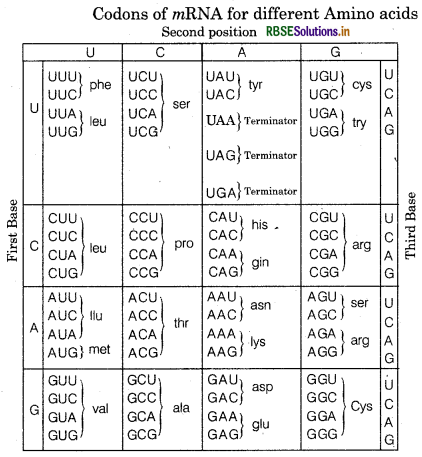
Features of Genetic Code:
Genetic code has certain basic characteristics, these are as follows:
- Triplet Nature
- Genetic code is non - overlapping
- The code is Commaless
- The code is universal
- The code is degenerative
- The code is Non - ambiguous
- Genetic code has Chain Initiation and Chain Fermination Codons
- The code is Colinear
Short Answer Type Questions-II
Question 1.
Briefly explain the different types of RNA.
Answer:
There are three different types of RNA:
- Messenger RNA (mRNA): A messenger RNA molecule is a single strand (not a double strand) about a thousand nucleotides long. Massenger RNA is involved in carrying the genetic code from the DNA in the nucleus to the ribosomes in the cytoplasm where protein is synthesized.
- Ribosomal RNA (rRNA): Molecules of ribosomal RNA are large and complex, often forming a double helix. Ribosomes are made up of rRNA and protein.
- Transfer RNA (fRNA): These are small molecules, about 80 nucleotide long. Transfer RNA molecules bring amino acids to the ribosomes so that the protein can be assembled.
Question 2.
(i) Differentiate between a template strand and coding strand of DNA.
(ii) Name the source of energy for the replication of DNA.
Answer:
(i)
|
Template Strand |
Coding Strand |
|
1. It is the strand of DNA which takes part in transcription. |
1. It is the strand that does not take part in transcription. |
|
2. The polarity is 3' → 5'. |
2. The polarity is 5' → 3'. |
|
3. Nucleotide sequence is complementary to the one present in mRNA. |
3. The nucleotide sequence is same as the one present in mRNA except for presence of thymine instead of uracil. |
(ii) The source of energy for the replication of DNA are the deoxyribose nucleoside triphosphate that have two terminal high energy phosphates.
Question 3.
(i) A DNA segment has a total of 1000 nucleotides, out of which 240 of them are adenine containing nucleotides. How many pyrimidine bases this DNA segment possesses?
(ii) Draw a diagramatic sketch of a portion of DNA segment to support your answer.
Or
(i) A DNA segment has a total of 1500 nucleotides, out of which 410 are guanine containing nucleotides. How many pyrimidine bases this segment passesses?
(ii) Draw a diagrammatic sketch of portion of DNA segment to support your answer.
Answer:
(i) According to Chargaff s rule, ratio of purine to pyrimidine is equal
i.e., A + G = C + T
The number of adenine (A) is equal to the number of thymine (T).
A=240 (given)
Therefore, T = 240
Also, the number of guanine (G) is equal to cytosine (C).
Thus, G + C = 1000 - [A + T]
G + C = 1000 - 480 = 520
Hence, G = 260, C = 260
The number of pyrimidine bases
i.e., C + T = 240 + 260 = 500
Or
(i) Given G = 410, therefore C = 410
A + T = 1500 - (G+C)
= 1500 - 820 = 680
Hence, A= 340, T= 340
The number of pyrimidine bases
i.e., C + T = 410 + 340 = 750
(ii)
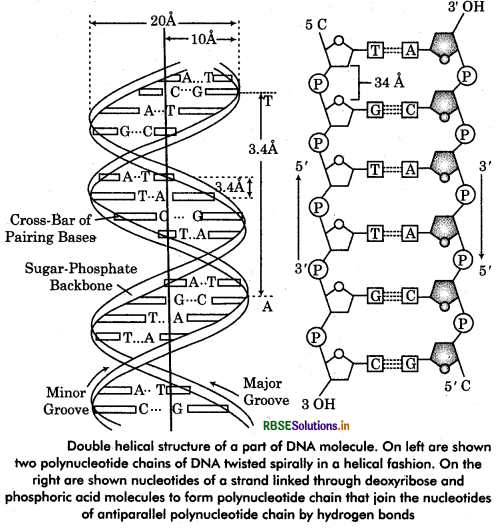
Question 4.
Explain the significance of satellite DNA in DNA fingerprinting technique.
Answer:
A DNA satellite is a portion that consists of short DNA sequences repeated many times. The variation between individuals in the lengths of their DNA satellites forms the basis of DNA fingerprinting.
DNA satellites are of two types: Microsatellites and minisatfellites. Their characteristic that makes them useful for identification is that they are highly polymorphic. The length of each satellite in DNA is inherited. The length of satellite portion is highly variable between people. These form small peaks during density gradient centrifugation and thus, are invaluable for identification purposes.
Question 5.
(i) What do TP and ‘B’ stand for in ‘YAC’ and ‘BAC’ used in Human Genome Project (HGP)? Mention their role in the project.
(ii) Write the percentage of the total human genome that codes for protein and the percentage of discovered gene whose functions are known as observed during HGP.
(iii) Expand SNPs identified by scientiests in HGP.
Answer:
(i) ‘Y’ stand for yeast in the word YAC (Yeast Artificial Chromosome) and ‘B’ stands for bacteria in the word BAC (Bacterial Artificial chromosomes). These are used as vectors in cloning of DNA.
(ii) Less than 2% of the total human genome codes for protein. Functions of 50% of discovered genes are not known.
(iii) SNPs stands for single nucleotide polymorphism.

Question 6.
Study the diagram given below:
Name the linkage X, Y, Z and the respective molecule formed by them.
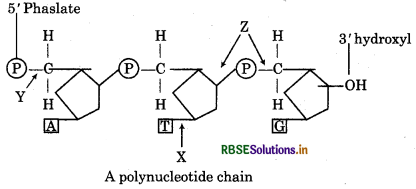
Answer:
X: N - glycosidic linkage. It forms nucleoside.
Y: Phosphoester linkage. It forms nucleotide.
Z: 3'- 5'phosphodiester linkage. It formed polynucleotide.
Question 7.
Describe the experiment that helped demonstrate the semi - conservative mode of DNA replication.
Or
How was a heavy isotope of nitrogen used to provide experimental evidence to semi - conative mode of DNA replication?
Or
‘DNA is a genetic material’. Prove it with the help of Hershey -, Chase experiment. Draw a linear diagram of the experiment.
Answer:
The perticularity of each cell, individual lies in uniqueness of its proteins. The cells are capable of synthesising - specific proteins by the information flowing from DNA. This information exists as the particular sequences of nitrogeneous bases in the DNA stands and forms the basis of genetic code. It moves to the protein manufacturing machinery (in cytoplasm) in the form of mRNA synthesised on DNA template. The sequence of amino acids in the polypeptide (which is to be synthesised) is determined by the sequence of bases in the mRNA.
It means the precise sequence of only four nitrogenous bases on the DNA strand directs the proper amino acids to their proper places in a polypeptide chain through the intervention of four nitrogenous bases of RNA, i. e., A, G, C and U. Nature of Genetic Code : There are 20 types of amino acids formed in cytoplasm and only four types of nucleotides are present in DNA. Apparently one - to - one correlation between nucleotides and amino acids is not possible. If one base codes for one amino acids, only four amino acid could be specified, i.e., the protein could contain only four amino acids. If a sequence of two bases codes for one amino acid, the four bases could spacify 1 - 6 (4 x 4) amino acids.
It does not fulfil the requirement of an appropriate genetic code. George Gamow, a physicist in 1954 argued that since there are only four nitrogenous bases but they have to code for 20 amino acids, each codon should have a combination of three nitrogenous bases, i.e., a combination of three bases would generate 64 codons (43 = 4 x 4 x 4 = 64 codons). Hence, a sequence of three bases forms triplet codon. it is the simplest code that can account for the 20 amino acids. In DNA molecule the sequences of bases triplets constitute the genetic code. The genetic code may also be defined as the sequence of base triplets in DNA molecule, each triplet representing an amino acid of a polypeptide. Conventionally 5’ → 3’ direction is used to write the code.
Crick (1961) stated that three consecutive nucleotides of mRNA strand determine the position of a single amino acid in a polypeptide chain. Neirenberg and Mathai ultimately provided experimental evidence to prove that the genetic code is a triplet one. In 1861. Nirenberg deciphered the first codon UUU for phenylalanine. Nirenberg and Hargovind Khorana have determined which sequences of bases coded for which amino acids with the help of many deligents. For this work, they were awarded Nobel prize in 1968. The genetic code anumerated by them in the following checker - board.
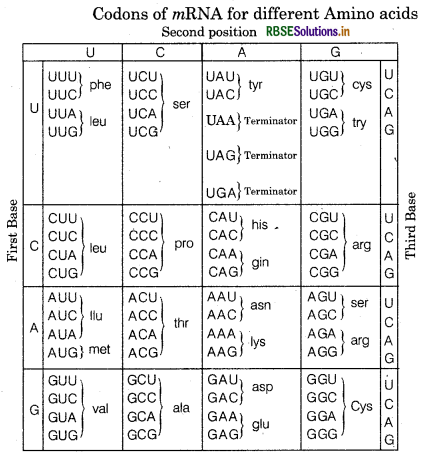
Features of Genetic Code:
Genetic code has certain basic characteristics, these are as follows:
- Triplet Nature
- Genetic code is non - overlapping
- The code is Commaless
- The code is universal
- The code is degenerative
- The code is Non - ambiguous
- Genetic code has Chain Initiation and Chain Fermination Codons
- The code is Colinear .
Question 8.
(i) How many codons code for amino acids and how many are unable to do so?
(ii) Why are codes said to be:
(a) degenerate and (b) unambiguous.
Answer:
(i) Out of 64 codons, 61 codes for amino acids and rest and 3 codons do not code for any amino acids. These functions as stop codons.
(ii) (a) Some amino acids are coded by more than one codon, so the code is degenerate, e.g., serene is coded by 6 codons.
(b) Unambiguous codon, codes for only one amino acid, these making the genetic code unambiguous and specific e.g. ,UUU.
Question 9.
(i) List the two methodologies which were involved in human genome project. Mention how they were used.
(ii) Expand ‘YAC’ and mention what was it used for.
Answer:
(i) Two major methodologies involved in human genome project are as follows:
- Expressed Sequence Tags (ESTs): This method focuses on identifying all the genes that are expressed as RNA.
- Sequence Annotation: This method involves the sequencing of whole set of genome (that contained all coding and non-coding sequence) and then assigning functions to the different regions in the sequence.
(ii) YAC, stands for yeast artificial chromosome. These were used as vectors in fragments of whole DNA of human were inserted and cloned.
Question 10.
‘DNA replicates semiconservatively’. Prove it with the help of Mathew Meselson and Franklin stahl experiment. Draw the linear diagram of the experiment.
Answer:
Duplication of DNA molecule to produce its identical copies is known as DNA replication. Whenever a cell divides, it needs to carry out DNA replication prior to each cell division. Duplication of DNA takes place during 3 - phase of the cell cycle when chromatin remains in extended form.
While proposing the double helical structure for DNA, Watson and Crick had immediately proposed a scheme for replication of DNA. To abduce their original statement that is as follows :
“It has not escaped our notice that the specific pairing we have postulated immediately suggests a possible copying mechanism for the genetic material.”
Semiconservative Method of Replication of DNA:
A very simple method of DNA replication suggested by Watson and Crick in 1953, on the basis of double helical structure of DNA molecule. Their scheme suggested that the two strands would separate and act as a template for the synthesis of new complementary strands. During a replication, he weak hydrogen bonds between the nitrogenous bases of nucleotides separate and the two polynucleotide chains of DNA uncoil and separate. Because of the specificity of base pairing, each nucleotide of separated chains attracts its complementary nucleotide from the cell cytoplasm. Once the nucleotides are attached by their hydrogen bonds, their sugar radicals unite through their phosphate components. Completing the formation of a new polynucleotide chain.
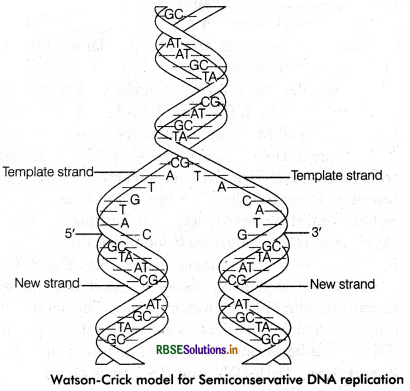
After the completion of replication, each DNA molecule would have one parental and one newly synthesised strand. This method of DNA replication is described as semiconservative method. Each daughter DNA molecule is a hybrid, conserving one parental polynucleotide chain and synthesising the other one.
Question 11.
Why is DNA molecule considered as a better hereditary material than RNA molecule?
Or
Why is DNA a better genetic material when compared to RNA?
Answer:
DNA is considered a better genetic material when compared to RNA because of its high stability and low reactivity. RNA being more reactive is labile to easily degradable. The high reactivity of RNA is contributed by the 2 - OH group in the nucleotide. RNA as a catalyst (e.g., ribozyme) is also more reactive Uracil present in RNA makes it unstable over DNA that contains thymine.
Question 12.
Name the three polymerases found in eukaryotic cells and mention their functions.
Answer:
Three types of RNA polymerases are found in eukaryotic cells and their functions are as follows:
- RNA polymerase - I: Transcribes rRNAs.
- RNA Polymerase - II: Transcribes the precursor of mRNA called /mRNA.
- RNA Polymerase - III: Transcribes /RNA, 5S rRNA and snRNAs.
Question 13.
Answer the following questions based on Meselson and Stahl’s experiment on E.coli.
(i) Write the name of the chemical substance used as the only source of nitrogen in the experiment.
(ii) Why did they allow the synthesis of the light and the heavy DNA molecules in the organism?
(iii) How did they distinguish the heavy DNA molecules from the light DNA molecules?
(iv) Write the conclusion the scientists arrived at the end of the experiment.
Answer:
(i) Ammonium chloride (NH4Cl) with N14 atom.
(ii) It is show that after one generation E. coli with 15N - DNA in a medium of 18 N, has DNA of intermediate density between the light and heavy DNAs. It shows that of the two strands, only one strand is synthesised newly, using the 14 N - nitrogen source in the medium.
(iii) The heavy and light DNA molecule can be differentiated by centrifugation in a cesium chloride (CsCl) density gradient. The 15N - DNA was heavier then 14N - DNA and the hybrid 15N - 14N - DNA was intermediate between the two newly formed DNA strands.
(iv) Scientists concluded that the DNA replication is semiconservative i. e., at the two strands of DNA, one is the parental strand, while the other is newly synthesised.
Question 14.
A very small sample of tissue or even a drop of blood can. help determine paternity: Provide a scientific explanation to substantiate how it is possible?
Answer:
DNA fingerprinting is the basis of paternity testing in case of disputes. This method is used to distinguish between - individual of same species by using their DNA sample. The DNA is isolated from the tissue or a drop of blood and further amplified to produce more copies by using polymerase chain reaction. This amplified DNA is further processed to detect the presence of similarities between the parent and child. Because the DNA from sample can be amplified to produce many copies in DNA fingerprinting, only a very small sample of tissue or even a drop of blood can help determine paternity.
Question 15.
Expand ‘BAC’ and ‘YAC’ what are they and what is the purpose for which they are used?
Answer:
BAC: Bacterial Artificial Chromosome.
YAC: Yeast Artificial Chromosome.
‘BAC’ and TAC’ are used as vector in cloning of DNA.
Long Answer Type Questions
Question 1.
Write properties of genetic material. Explain with a diagram, the experiment of Alfred Hershey and Martha Chase that DNA is a genetic material.
Answer:
It was established from the above experiments that DNA is the genetic material in most organisms except in plant viruses and some animal viruses such as retrovirus, hepatitis-C virus, orthomyxoviruses etc. When RNA acts as genetic material. You have already studied in this chapter, the features which genetic material must possess, such as stable structure yet capable of undergoing slow changes (mutations), replication and capable of transcription and translation. Now you find out why DNA is predominantly the genetic material and RNA performs dynamic functions of messenger and adapter. These differences in function of DNA and RNA can be determined to the differences in their chemical structures.
Let us consider the differences in the ability of DNA and RNA to act as genetic material.
1. Duplication: Both DNA and RNA have the ability to direct their duplication, because both follow the rule of base pairing and exhibit complementarity.
2. Stability: DNA is very stable. It is proved from Griffith’s experiment on ‘transforming principle’ which transformed non - virulent bacteria into virulent bacteria, even though it was collected from heat - killed virulent bacteria. It means that heating did not destroy the virulent property of DNA. It is now known that the two complementary strands break on heating. However, these strands rejoin when cooled gradually. Presence of thymine in DNA confers additional stability to DNA.
RNA is more reactive hence less stable. The 2' - OH group attached to second carbon atom of ribose (which is replaced by 2' - H in deoxyribose) is a reactive group and makes RNA easily degradable. Presence of uracil in place of thymine also makes RNA more labile. The single stranded structure of a long RNA molecule makes it less stable. Some RNA molecules acts as enzymes (ribozymes) hence very reactive, it concluded that DNA is more stable than RNA and is better suited to act as genetic material.
3. Mutation: Both DNA and RNA have an ability to undergo mutation but RNA mutates faster. Because of this viruses with RNA genome (e.g., polio and influenza virus) have shorter life span, mutate faster and evolve into new strains.
4. Expression: RNA can code directly for the synthesis of protein while DNA depends on RNA to transfer the message of protein synthesis from nucleus into the cytoplasm. Actually protein synthesis can not be taken place by DNA without RNA, whereas RNA can manage it without DNA.
Based on the above discription, it can be concluded that DNA being more stable is more suited for storage of genetic information and RNA for the transmission of information.
The undersiable proof that DNA is the genetic material came from the experiments of Alfred Hershey and Martha Chase (1952). They worked with viruses that infected bacteria called bacteriophages or T2 - Phages.
Bacteriophase (T2) has a hexagonal head and a long tail. The head is composed of DNA and protein. DNA fibres are found inside the protein coat in head. Tail is covered by tail sheath. At end of tail, a tail plate is found which is attached with six tail fibres. These bacteriophage can reproduce inside the living cell of Escherichia coli bacterium. When it comes in contact with a living bacterium, its DNA enters the cell but its protein coat remain outside. Inside the bacterial cell, the phage - DNA multiplies and produces a large number of new phages - DNA molecules. Each of these DNA - molecules develops its own protein coat forming daughter phage particles. Hershey and Chase conducted experiment on T2 - phage. They used different radioactive isotopes to label DNA and proteins.
1. First, they grew some phage with E. coli on medium containing radioactive sulphur (3o S). Sulphur is incorporated in the formation of amino acids: cysteine and methionine. Therefore, phages grown in radioactive sulphur contained radioactive protein coat. DNA lacks sulphur.
2. Some phases were grown with E. coli on medium having radioactive phosphorus (32P). Phosphorus is an important constituent of DNA but not found in protein. Therefore, bacteriophage grown in radioactive phsophorus contained only radioactive DNA.
These both types of radioactive phases were made to infact normal E. coli bacteria in two separate samples. The protein coats were separated from bacterial cells by shaking and centrifugation. About 20 minutes later the infection, the bacterial cells reptured liberating daughter phages. The phages grown in radioactive phosphorus passed their radioactivity to the daughter phage particles. The phage containing radioactive sulphur did not transmit their radioactivity to their daughter phages. Their radioactive sulphur was found in the protein coat left outside the bacterial cells.
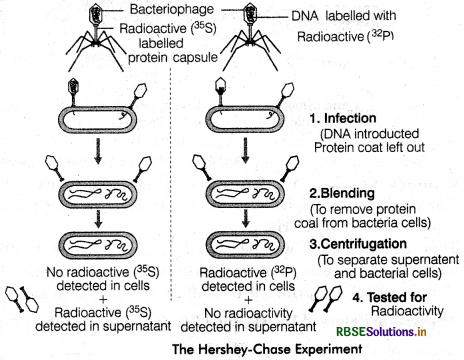
From above experiment Hershey and Chase concluded that, DNA not protein, was the genetic material. They determined that a protective protein coat was formed around the bacteriophage, but that the internal DNA is what conferred its ability to produce progency inside a bacterium.
RNA as Genetic Material:
Some viruses like tobacco mosaic viruses (TMV) do not have DNA, but have only protein and RNA. In such viruses, RNA acts as a genetic material. It was proved first by Frankel Conrat and Singer in 1957 on the basis of their experiments. The protein of TMV can be separated from RNA, and on mixing separated RNA and protein under favourable conditions, active TMV particles are formed again.
In tobacco, two strains of TMV : ‘A’ and ‘B’ produce different characters of mosaic. Conrat and Singer produced hybrid TMV particles by mixing RNA of strain ‘A’ with protein of strain ‘B’. When these hybrid TMV particles infect the tobacco plants, then same mosaic characters of strain ‘A’ were produced in tobacco plants. When TMV particles were separated from leaves of tobacco and tested then it was observed that both RNA and protein were similar to strain ‘A’ in it. Likewise, hybrid TMV are produced by mixing strain ‘A’ protein and strain ‘B’ RNA, these on infection produced mosaic symptoms which were same as strain ‘B’ RNA and protein.i lt comes to be known from the above experiments, that RNA is the genetic material in TMV.
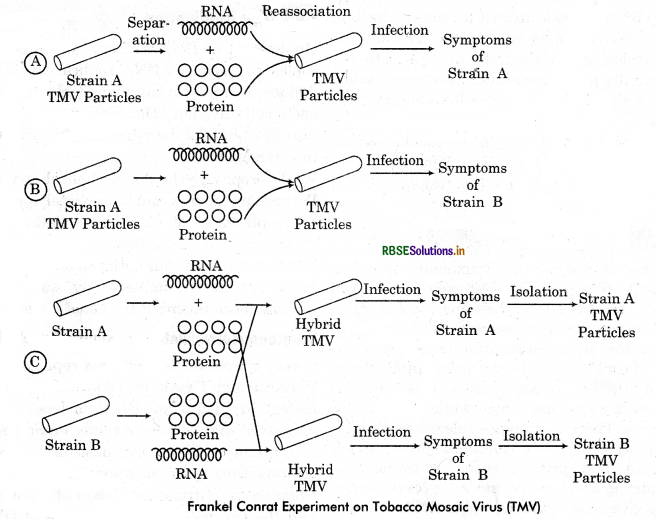
In some other viruses causing disease such as poliomyletes, influenza, AIDS, encephalitis etc., in animals, most of the plant viruses and some microbacteriophages such as MS2, R17 etc., genetic material is of RNA.

Question 2.
What is nucleosome? Draw diagram of double stranded polynucleotide chain of DNA and explain its structure.
Answer:
We know that human cell contains at least 2 m of DNA packed into a nucleus is about 5 pm in diameter. The nucleosomes are responsible for packaging the DNA so that it can fit into such a small space. Nucleosomes are submicrOscopic units of chromation. These were named so by Oudet et al (1975) who proposed the nucleosome concept of DNA and protein association. A nucleosome is an oblate structure, about 11 nm in diameter and 5.6 - 6 nm in height. It is formed of core particle of histone octamer (H2A, H2B, H3 and H4 ; each has two copies) tightly wrapped with approximately two (1.75) circles of DNA of 146 nucleotide pairs. The two adjacent nucleosomes are connected by a linker DNA or interbead DNA. Histone protein H4 is connected with linker DNA and appears to mediate this coiling process. A typical nucleosome has 200 bp of DNA helix.
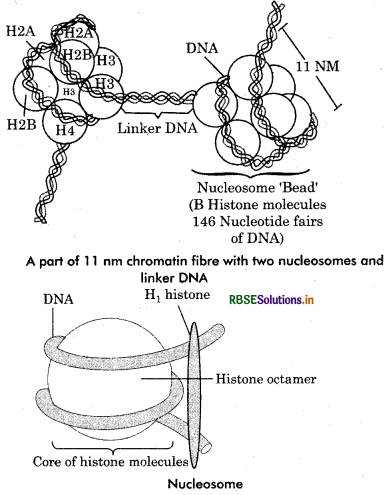
Nucleosome represents the first level of DNA packaging where 200 bp on packed in one nucleosome. It means a human nucleus 6.6 x 109 base pairs are packed in 3.3 x 107 nucleosome (6.6 x 109 bp/200 bp = 3.3x107 nucleosomes).
Super Solenoid Structure of Nudeoprotein Fibre (Nucleosome Packaging):
Nucleosomes are the fundamental packing unit particles of the chromation and give chromation a “beads - on - a- string”, appearance in electron micrographs taken after treatments that unfolds higher order packing. This chromation is a linear array of nucleosomes is 11 nm in thickness. This 11 nm thick chromation fibre gives rise to 30 nm thick chromation by spiral coiling, it has a solenoid type of ultrastructure. It further coils to form 300 nm fibre which has 6 - 7 nucleosome per turn. During cell division, the solenoid is packed into another helix, the supersolenoid is condensed further to produce the final shape and dimensions of metaphase or anaphase chromosome.
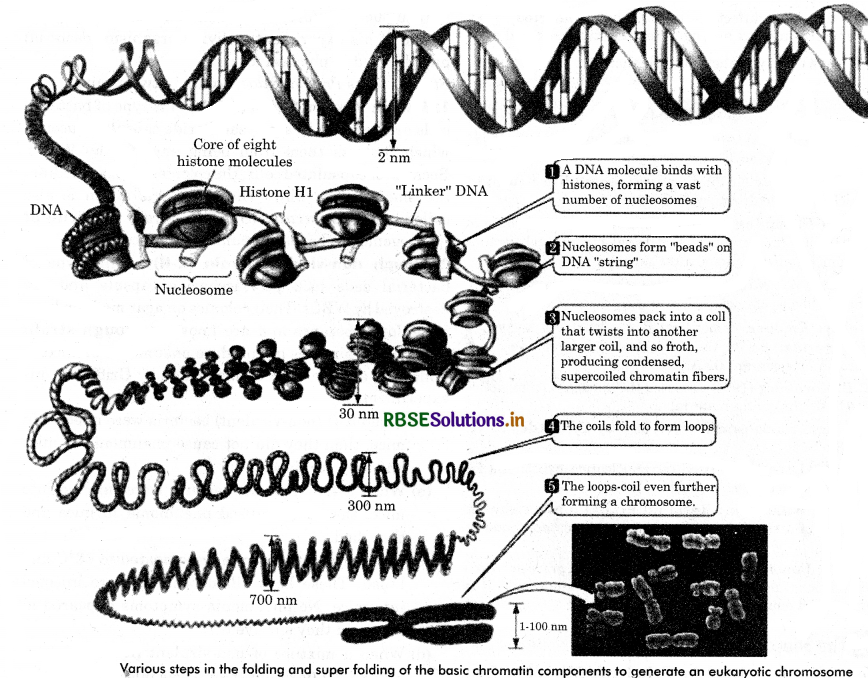
Question 3.
How did Hershey and Chase established that DNA is transferred from virus to bacteria?
Answer:
Harshy and Chase (1952) established that DNA is transferred from viruses that infect bacteria. In their experiment, bacteriophage were used. They grew some phages on a medium that contained radioactive phosphorus and some others on medium containing radioactive sulphur. Phages grown in the presence of radioactive phosphorus contained radioactive DNA, but not radioactive protein because DNA contains phosphorus, but protein does not. In the same way, phages grown on radioactive sulphur contained radioactive protein, but not radioactive DNA because DNA does not contain sulphur. Radioactive phages were allowed to attach to E. coli bacteria. As the infection proceeded, virus coats were removed from the bacteria by agitating them in a blender. The virus particles were separated from the bacteria by spinning them a centrifuge.
Question 4.
Answer the following questions based on Harshey and Chase’s experiments:
(i) Name the kind of virus they worked with and why?
(ii) Why did they use two types of culture media to grow viruses in? Explain.
(iii) What was the need for using a blender and later a centifuge during their experiments?
(iv) State the conclusion drawn by them after the experiments.
Answer:
(i) The worked with bacteriophases i. e., viruses that infect bacteria. These phages were used because during infection they transfer their genetic material into bacteria.
(ii) They used two types of culture media: Containing 35S and 32P so as to compare that which one out of DNA and proteins get transferred from virus to bacteria and acts as genetic material.
(iii) A blender and centrifuge were used to open up the bacterial cells and viral particles, so that genetic material could be exposed.
(iv) Conclusion is that the DNA is genetic material.
Question 5.
What is nucleosome? Explain the packaging of DNA helix. Draw the labelled diagram of nucleosome.
Answer:
We know that human cell contains at least 2 m of DNA packed into a nucleus is about 5 pm in diameter. The nucleosomes are responsible for packaging the DNA so that it can fit into such a small space. Nucleosomes are submicrOscopic units of chromation. These were named so by Oudet et al (1975) who proposed the nucleosome concept of DNA and protein association. A nucleosome is an oblate structure, about 11 nm in diameter and 5.6 - 6 nm in height. It is formed of core particle of histone octamer (H2A, H2B, H3 and H4 ; each has two copies) tightly wrapped with approximately two (1.75) circles of DNA of 146 nucleotide pairs. The two adjacent nucleosomes are connected by a linker DNA or interbead DNA. Histone protein H4 is connected with linker DNA and appears to mediate this coiling process. A typical nucleosome has 200 bp of DNA helix.
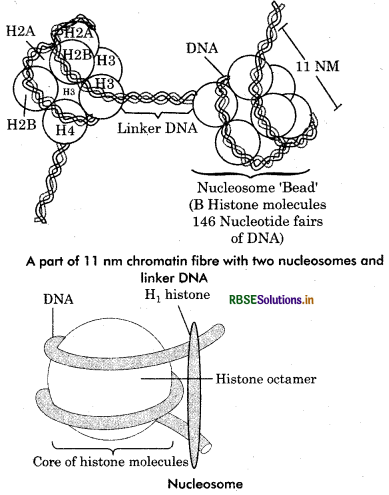
Nucleosome represents the first level of DNA packaging where 200 bp on packed in one nucleosome. It means a human nucleus 6.6 x 109 base pairs are packed in 3.3 x 107 nucleosome (6.6 x 109 bp/200 bp = 3.3x107 nucleosomes).
Super Solenoid Structure of Nudeoprotein Fibre (Nucleosome Packaging):
Nucleosomes are the fundamental packing unit particles of the chromation and give chromation a “beads - on - a- string”, appearance in electron micrographs taken after treatments that unfolds higher order packing. This chromation is a linear array of nucleosomes is 11 nm in thickness. This 11 nm thick chromation fibre gives rise to 30 nm thick chromation by spiral coiling, it has a solenoid type of ultrastructure. It further coils to form 300 nm fibre which has 6 - 7 nucleosome per turn. During cell division, the solenoid is packed into another helix, the supersolenoid is condensed further to produce the final shape and dimensions of metaphase or anaphase chromosome.
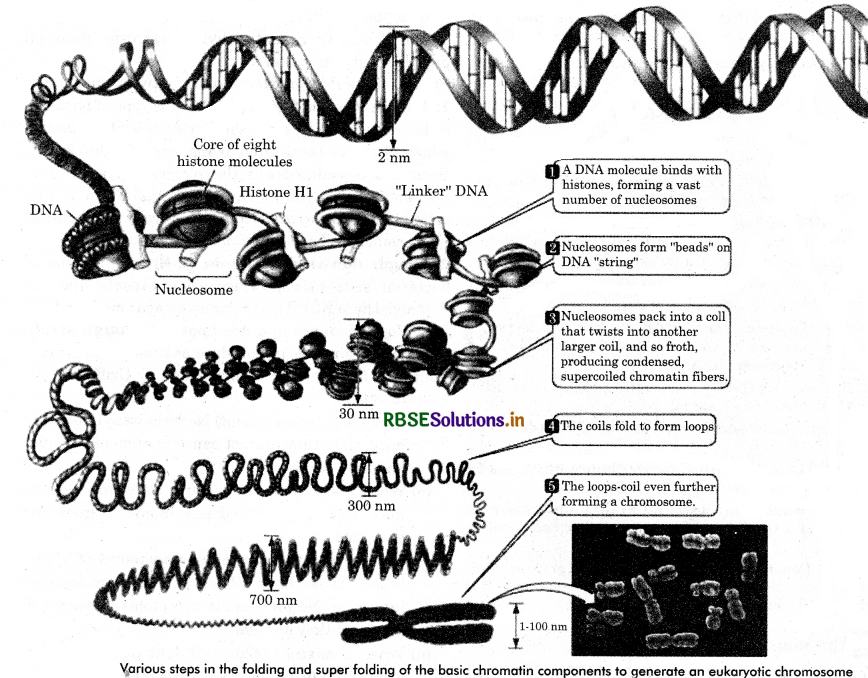
Question 6.
What is transcription? Explain the process of transcription in bacteria by labelled diagram.
Answer:
The process of copying genetic information from one strand of the DNA into mRNA is known as transcription. The transcribed RNA moves out of the nucleus to the ribosomes in the cytoplasm to direct protein synthesis. Time and Site of Transcription.
Transcription takes place in the nucleus during G1 and G2 phases of cell cycle during interphase. DNA has promotor and terminator sites. Transcription begins at the promotor site and stops at the terminator site. Out of two strands of DNA only one strand is transcribed. Since RNA is synthesised in 5' → 3' direction, it is transcribed only on DNA strand having 3' → 5' polarity. The 3' → 5' DNA strand (from which) RNA is transcribed is known as template strand or antisense antitemplate strand or sense strand or coding strand. The coding DNA strand has the same sequence of nitrogenous bases as the RNA transcript except that in RNA thymine (T) is substituted by uracil (U). It has the same polarity : 5' → 3' as the RNA transcript. Discovery of RNA Synthesis : The whole mechanism of RNA synthesis was discovered by three American scientists Jerard Hurwits, Samuel B. Weiss and Audrey Stevens in 1950s.
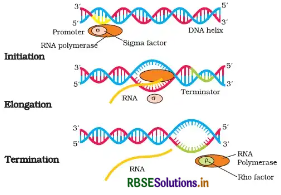
Question 7.
(i) State the ‘central dogma’ as proposed by Francis Crick.
(ii) Explain, how the biochemical characterisation (nature) of "Transforming Principle’ was determined, which was not defined from Griffith’s experiments.
Answer:
(i) Francis Crick proposed the central dogma of molectilar biology. Which states that genetic information flows from DNA to mRNA (transcription)
and then from mRNA to protein (translation) always unidirectionally (excepts bîdirectionally in some viruses and the process is called reverse transcription).

(ii) Several experiments were conducted to prove that DNA, is the genetic, material. Griffith conducted his experiments and concluded that some substance causes transformation. However, he did not tell the substances that had caused the transformation.
Biochemical characterisation of Transforming Principle Avery, MacLeod and McCarty revealed that the chemical nature of the transforming substance was DNA. They showed that DNA isolated from S-strain could itself conferthe pathogenic properties to R-strain. This fact suggested that DNA possesses the genetic properties."
Q.8. Study the schematic representation of the genes involved in the lac operon given below and answer the question that follows:
|
P |
i |
P |
o |
Z |
y |
a |
(i) Identify and name the regulatory gene in this operation. Explain its role in ‘switching off the operon’.
(ii) Why is lac operon’s regulation reffered to as negative regulation?
(iii) Name the inducer molecule and the products of the gene Z and Y of the operon. Write the function of these gene products.
Answer:
(i) i gene: regulatory gene.
It codes for the repressor protein of the operon, which is synthesised constitutively. The repressor has the affinity for the operator gene. It binds to the operator and prevents the RNA polymerase from transcribing the structural genes.
(ii) When repressor binds to the operator, the operon is switched off and transcription is stopped. So, it is known as negative regulation.
(iii) Lactose is an inducel molecule.
Gene ‘Z’ codes for ß-galactosidase, which is responsible for the hydrolysis of lactose into galactose and glucose.
Question 9.
Differentiate between Translation in Prokaryotes and Eukaryotes.
Answer:
Difference between Translation in Prokaryotes and Eukaryotes
|
Translation in Prokaryotes |
Translation in Eukaryotes |
|
1. In this ribosomes are of 70S type. |
1. In this ribosomes are of 80S type. |
|
2. mRNA is polycistronic. |
2. mRNA is monocistronic. |
|
3. Three initiation Factors IF1, IF2 and IF3 are required for initiation. |
3. About 10 initiation factors are required. |
|
4. First amino acid for the initiation of synthesis is formylated methionine (F-mat). |
4. First amino acid for initiation of synthesis is methionine (met). |
|
5. Elongation factors are EF-Tu and EF - Ts. |
5. Elongation factors is eEF1. |
|
6. Transcription coupled translation occur in prokaryotes. |
6. Translation occurs only after transcription of m - RNA is completed and it comes out of the nucleus into the cytoplasm. |
|
7. It is speedy, about 20 amino - acids are added per second. |
7. Translation is slow, only one amino acid is added per second. |
